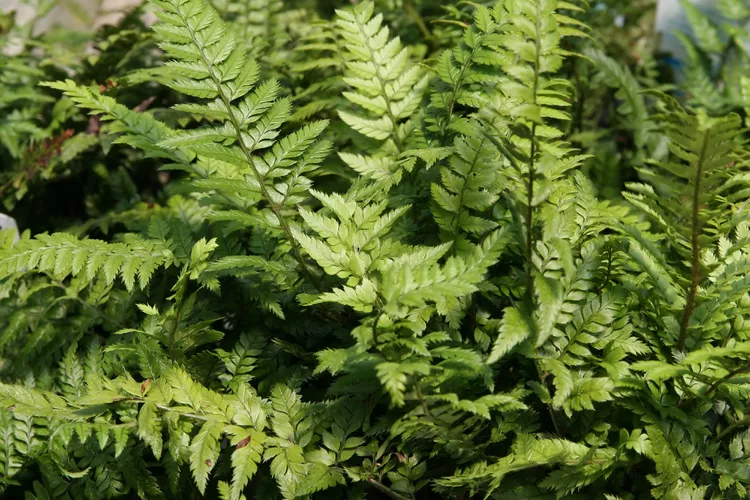Korean rock ferns (Polystichum tsus-simense) are beautiful and easy-to-grow ferns that can be grown both indoors as a houseplant and outdoors as a garden plant in warmer climates (USDA Hardiness Zones 7-10). Native to eastern Asia, these ferns are often found growing on rock walls in locations from full sun to full shade. Their ability to grow in deep shade and where they regularly dry out, along with their persistent green fronds and dark stems, make Korean rock ferns an excellent choice for protected areas outdoors where few other plants will survive. Indoors, these ferns can grow in less light than other common houseplants.
Korean Rock Fern Overview
| Genus Name | Polystichum tsus-simense |
| Common Name | Korean Rock Fern |
| Plant Type | Houseplant, Perennial |
| Light | Part Sun |
| Height | null to 20 Inches |
| Width | null to 18 Inches |
| Foliage Color | Blue/Green |
| Zones | 10, 7, 8, 9 |
| Propagation | Seed |
Where to Plant Korean Rock Ferns
In general, Korean rock ferns perform best as an indoor plant but can be grown outdoors in warm, wet climate zones. Being small, clump-forming plants, they do not require frequent repotting and can be grown with similarly sized plants that have similar cultural requirements. Forced air vents, fans, and cold drafts should be avoided.
Outdoors, Korean rock ferns will do well in protected locations with bright, indirect light and regular moisture, but they can survive with some drying between waterings. Because of their fibrous root system, they do well in locations with shallow soils, but benefit from mulching for more consistent moisture. Avoid planting these ferns near aggressively spreading plants such as lilyturf (Liriope spp.) or English ivy (Hedera helix).
How and When to Plant Korean Rock Ferns
Outdoors, plant Korean rock ferns in spring to allow plants to become established throughout the growing season. Dig a hole twice the width of the root ball and set in the center of the hole. Sprinkle some granular fertilizer around the root ball and refill with soil. Water gently and maintain moisture throughout the first growing season.
Care Tips for Korean Rock Fern
Light
These ferns prefer bright indirect light, but can acclimate to full sun in cooler conditions. Korean rock ferns can also grow, but not thrive, in dimmer lighting where they will maintain their color, but show very little growth.
Soil and Water
Korean rock ferns prefer moist conditions, but will not tolerate standing water for long periods of time so make sure to plant it in well-drained soil. In a container, potting mix with added perlite will ensure ample moisture retention while maintaining proper drainage.
Temperature and Humidity
As with most ferns, these plants will do best when given warm temperatures and high humidity. Temperatures over 90°F or lower than 32°F will slow growth or kill plants.
Maintain humidity around plants outdoors by applying an organic mulch around uncovered soil. Indoors, Korean rock ferns will do best in more humid locations around the house such as the kitchen and bathrooms.
Fertilizer
A balance fertilizer once a month, while plants are actively growing, will keep plants green and thriving. Outdoors, the addition of compost and mulch to the soil will help keep moisture locked in the soil while also supplying plants with nutrients.
Potting and Repotting
When grown indoors, Korean rock ferns can be repotted anytime during the year. Due to clumping growth, plants only require repotting when they have begun to outgrow their current pot. Excessive root growth from the bottom of the pot and bulging sides (in plastic pots) will indicate repotting is necessary.
Pests and Problems
Korean rock ferns experience few diseases aside from root rot and mealybugs. Root rot can be avoided by using a well-draining soil mix and never allowing plants to sit in standing water. Treat mealybugs with an organic pesticide such as neem oil. Individual mealybugs can be removed with your fingers if you aren't squeamish.
How to Propagate Korean Rock Fern
Like most ferns, Korean rock ferns grow from spores and require at least a year before true fronds are noticeable. But if you're patient, you can collect spores and grow them into new ferns.
- Fill a small plastic container about halfway with evenly moist potting mix.
- Hold fertile fronds over the container, spores facing down, and tap or flick the tops to allow spores to settle on the soil surface. Fern spores are brown and dust-like, making them hard to see once they’ve touched the soil. A white sheet of paper can also be used to collect spores before applying them to the soil.
- Cover the container and place it in a warm, bright location away from direct sunlight and cold drafts.
- After a week, check to make sure the soil is still moist and spritz with a water bottle if necessary. Repeat weekly to maintain moisture.
- Over time, green structures will begin to grow on the soil surface. These will become new fern plants in time. Continue spritzing with water until the first true fronds begin to appear.
- Once at least three fronds have grown on plants, they can be gently removed and repotted.
Companion Plants for Korean Rock Fern
Outdoors, plant your Korean rock ferns with non-aggressive plants such as wild ginger (Asarum candense), smaller hostas (Hosta spp.), and lungwort (Pulmonaria spp.)
Ferns pair well with other moisture-loving houseplants such as peace lilies (Spathiphyllum spp.), pilea (Pilea spp.), and pothos (Pothos spp.).




















